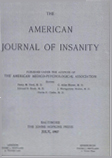MUTISM AND RESISTANCE BEHAVIOR IN PSYCHOTIC PATIENTS
Abstract
This paper presents a psychiatric and physiologic study of eight groups of patients. Four groups of communicative patients offer confirmation of the difference in physiologic response associated with resistant and nonresistant behavior.
In addition we offer data on mute patients where the study of the behavior during the laboratory procedure and in the ward enabled us to differentiate four groups, resistance mutism, resistance mutism with tension or anxiety, mutism associated with passive submissive attitudes, and indifference mutism.
The problem of determining the presence of psychologic resistance in the absence of verbal replies has been outlined. Experience has shown that it is possible to gain an impression of the patient's attitude not, however, infallible, from his affective reactions to the examiner. When such observations are evaluated it is believed to be possible to distinguish resistance, passive masochistic submission, and indifference.
The resistant mute cases, with overt affect at the time the questions were asked, clearly indicated that these patients were emotionally reacting to our stimuli. The hostile nature of the resistance was evidenced by the character of the overtly manifested affect and the patients' antagonism to the test procedure. The indifferent patients appeared to be wholly out of emotional contact except for isolated instances in which they reacted selectively to certain ideational or some sensory stimuli. It may be inferred that the indifferent patients were either (1) completely absorbed in their own autistic thinking or (2) that the capacity for physiologic response was impaired or (3) that perceptual mechanisms were not functioning.
The physiologic study of these four groups of mute patients shows that with the resistant cases there is a predominance of smaller galvanic responses in the presence of definite blood pressure reactions suggestive of neural or humoral inhibition of autonomic responses; with the passive submissive patients there are strong reactions by both the galvanic and blood pressure mechanisms suggestive of uninhibited autonomic response, and with indifference mutism both responses tend to be small, suggestive of diminished autonomic activity.
Access content
To read the fulltext, please use one of the options below to sign in or purchase access.- Personal login
- Institutional Login
- Sign in via OpenAthens
- Register for access
-
Please login/register if you wish to pair your device and check access availability.
Not a subscriber?
PsychiatryOnline subscription options offer access to the DSM-5 library, books, journals, CME, and patient resources. This all-in-one virtual library provides psychiatrists and mental health professionals with key resources for diagnosis, treatment, research, and professional development.
Need more help? PsychiatryOnline Customer Service may be reached by emailing [email protected] or by calling 800-368-5777 (in the U.S.) or 703-907-7322 (outside the U.S.).



